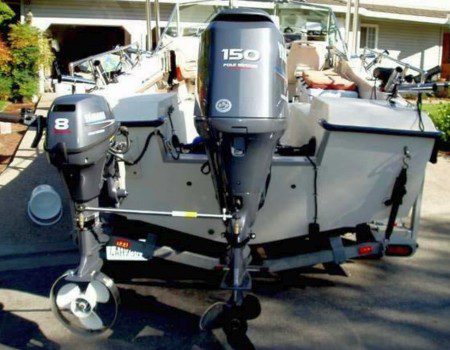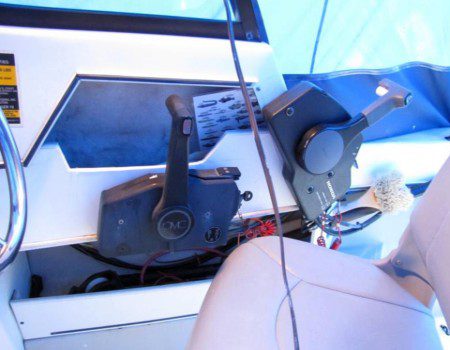 By Bob Currie, Recreational Boating Safety Specialist
By Bob Currie, Recreational Boating Safety Specialist
U. S. Coast Guard Auxiliary Station Galveston Flotilla
What is a Kicker?
If I tell you to simply look at the picture below and see if you can figure out what a kicker is, I think you could do it. Everyone knows someone who has what is called a twin engine boat. A twin engine boat has two separate engines of the same make and horsepower (hence the term “twin”). The boat in the picture below has two engines, but they are definitely not the same horsepower. So, does adding the smaller engine make the boat above a 158 hp boat? No. Instead, you have a 150 hp boat and an 8 hp boat.

What are the Uses for a Kicker Engine?
If you were to ask another recreational boater “What’s that for?” and point to a kicker, you might get one of several answers:
- On a sailboat, it is the auxiliary engine
- On a fishing boat it could be for trolling
- On any boat it could be for emergency use if the primary engine fails
- On a Coast Guard Auxiliary boat it could be for meeting the alternate propulsion requirement of the Coast Guard Operating Facility (OPFAC) standards.
Sailboat Auxiliary Engine
If you have ever emmulated Otis Redding and sat on the dock of the bay, watching the ships roll in (and watching them roll away again), you would notice the big sailing rigs lower their sails as they enter the harbor and use their auxiliary engine to dock their vessels. Oh, not all of them- you can watch the “sailboat fails” on Youtube if you get bored. The prudent sailboat operator has a kicker mounted such that it doesn’t interfere with the rudder movement.
Trolling
Fishing is an exact science, as I have been told by many fishermen. I have a friend I fish with who gets upset when I hook a shrimp through the tail instead of the horn. Fishermen who routinely troll use trolling speed charts so they always catch the exact fish they are after (except for the occasional hardhead or gafftop; how dare they hit at the Redfish trolling speed of 1.5-3 mph?). Using the boat above with the 150 primary engine, the fisherman is not going to be able to go slow enough to troll for redfish, even at idle, with that big an engine unless he does one of the following:
- Use a trolling plate which drops in front of the propeller, directing water out to the side instead of directly behind the prop.
- Use a drift sock tied to a cleat to create drag on the boat
- Use an electric trolling motor (problem: limited by battery charge)
- Use the shifting in and out of gear technique (noisy, hard to fish and use this technique at the same time)
- Use an outboard kicker (can go for days on a couple of gallons of gas)
Primary Engine Fails
If you compare a boat with a single engine of 300 hp to a boat with twin 150 hp engines, the twin engine boat comes out ahead in reliability (you can usually get up on plane with twin engines) as well as economy (two smaller engines almost always consume less fuel than a single engine of matching horsepower). So, twin engines are recommended for those who routinely fish off shore. Coming in second is the single primary engine boat with an outboard kicker. While an electric trolling motor can get you back in if you are reasonably close to shore, It isn’t going to do the job if you are 10 miles out. A kicker, on the other hand, will run all day on a couple of gallons of gas. It won’t be a quick trip and you will never get your boat on plane, but you will get home with a kicker. You can safely go offshore with a kicker as long as your trip is not way out there.
Meeting OPFAC Standards
One criterion for meeting Coast Guard OPFAC requirements is to have alternate propulsion. This could be as simple as a paddle, or it could be an electric trolling motor, a twin engine craft, or a boat with a kicker. The Coast Guard recognizes that certain types of alternate propulsion have limitations, and our orders will be tailored to the limiting factor. An OPFAC may be limited to 10 miles offshore or be allowed to go out 70 miles. Alternate propulsion is only one of the considerations when our orders are written. Hull design, weather, and wave height in the area of operation also come into play when an offshore mission is in the works.
Kicker Installation Considerations
There are different ways to install a kicker. Here are some of the considerations:
- Most kickers are in the 5-10 hp range because of weight limits. Outboard motors are heavy, and adding a kicker could drop the weight capacity enough to reduce the number of persons the boat can carry.
- In addition, because the kicker is mounted to the side of the primary engine care must be taken to balance the load (cargo and passengers) so that the boat tracks truly rather than leaning to the side.
- Kicker installation must be far enough to the side to keep from interfering with the operation of the promary engine. Most kickers are mounted on the port side because the propeller rotates clockwise, and mounting the engine on the starboard side would make the boat harder to steer because of the direction of torque from a clockwise rotating propeller.
- Operation of the kicker controls can either be by the tiller or by a console mounted control box, as seen in the picture below. As you can see from the picture, the second set of controls takes up considerable room on this boat. If the kicker is only for emergencies, using the tiller may be the easiest way to go. If the kicker will be used for trolling, then having the throttle controls at the steering station would be the way to go.

Kicker Steering
Kicker steering may be accomplished in different ways. One way already mentioned is with the tiller handle. Another method is to link the kicker to the primary engine with tie rods so that the kicker engine is steered with the boat wheel. Another method is to fasten the kicker so that it does not move at all, and the steering is done by steering the primary engine, even if it is dead. The last method takes some experimenting. The key is to tighten the kicker in a position that causes the boat to track straight ahead. Using this method, the steering only works when the boat is underway. No maneuvering can be done unless the boat is moving.
Summary
If you are a boat owner and do not have any he-man paddlers on your crew, you may consider adding an outboard kicker engine to your transom, especially if you desire to go far from the shoreline. While an electric trolling motor will take you relatively short distances, a kicker will run all day, albeit at less than planing speed. You will get there, but not in time for supper.
For more information on boating safety, please visit the Official Website of the U.S. Coast Guard’s Boating Safety Division at www.uscgboating.org. SAFE BOATING!
[BC: Feb-21-2023]

 Posted in
Posted in 

























It was interesting to me when you talked about how a kicker motor can keep your boat running all day. With that in mind, I would think that it would be important to make sure that you don’t get a motor that is too powerful or too weak for your boat. It would probably be a good idea to consult with an expert in marine engines before you purchase an additional motor.